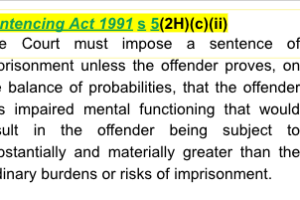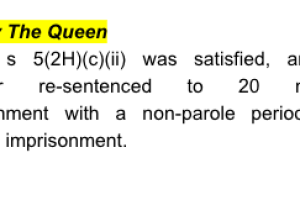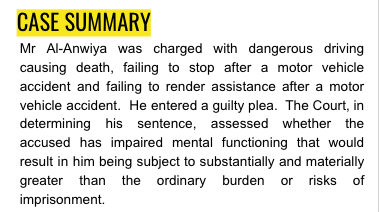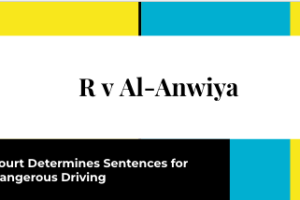Court Determines Sentences for Dangerous Driving

R v Al-Anwiya [2022] VSC 428 (29 July 2022)

Mr Al-Anwiya was charged with dangerous driving causing death, failing to stop after a motor vehicle accident and failing to render assistance after a motor vehicle accident. He entered a guilty plea. The Court, in determining his sentence, assessed whether the accused has impaired mental functioning that would result in him being subject to substantially and materially greater than the ordinary burden or risks of imprisonment.

Facts:
On the morning of Sunday 25 October, 2020 at approximately 11:15 am, Mr Al-Anwiya was driving his silver Nissan sedan along Silvester Parade in Roxburgh Park. He was aged 20 and a holder of a probationary driver’s licence. The applicable speed limit was 50 kilometres per hour. The weather was fine and the road surface was dry.
The victim in this matter, Mr Hermez, was 73 years old and lived in Roxburgh Park. It is believed that he was walking from his home to the local shops when the fatal collision occurred. The section of Silvester Parade where the collision occurred was a sweeping, uphill curve to the left. He was travelling in an easterly direction.
McPherson Boulevard, which meets Silvester Parade at a T-intersection, was on his right-hand side. On the south side of Silvester Parade, that was, on his left-hand side, is a footpath which runs alongside the road until just west of McPherson Boulevard. At this point, the footpath turns right and ends at the road’s edge.
There is no pedestrian crossing, lights, speed control devices or signage of any type. Mr Hermez was attempting to cross Silvester Parade at this point when he was struck by the front right-hand side of Mr Al-Anwiya's vehicle.
Mr Al-Anwiya immediately left the scene, quickly and without stopping. He did not attempt to render any assistance to Mr Hermez. Other motorists did stop and assist the victim, and police and an ambulance were called. Tragically, Mr Hermez died at the scene.
Mr Al-Anwiya was arrested shortly before noon. He was interviewed later that day with the assistance of an Arabic interpreter. He gave an account to the effect that the deceased appeared all of a sudden, and braked, and he does not remember anything after that. A sample of his blood was taken and tested, and no alcohol or illicit drugs were detected.
He admitted through his guilty plea that he was driving dangerously.

Issue:
Whether or not the accused has impaired mental functioning that would result in him being subject to substantially and materially greater than the ordinary burden or risks of imprisonment.

Applicable law:
Peers v The Queen [2021] VSCA 264 - where s 5(2H)(c)(ii) was satisfied, and the offender re-sentenced to 20 months’ imprisonment with a non-parole period of 8 months’ imprisonment.

Neskovski v The Queen [2022] VSCA 86 - provides that it does not follow that cumulation must be ordered in every case where both leaving the scene of an accident and failing to render assistance are charged.

Sentencing Act 1991 s 5(2H)(c)(ii) - provides that the Court must impose a sentence of imprisonment unless the offender proves, on the balance of probabilities, that the offender has impaired mental functioning that would result in the offender being subject to substantially and materially greater than the ordinary burdens or risks of imprisonment.

Sentencing Act 1991 s 5(2H)(e) - requires the court to evaluate whether there are substantial and compelling circumstances that are exceptional and rare and that justify not imposing a sentence of imprisonment.
Analysis:
His counsel submitted principles 5 and 6 of Verdins have applications. She submitted the existence of your PTSD means any sentence will weigh more heavily on him than it would on a person in normal health. He would, because of his PTSD, be subject to a substantially and materially greater burden than a prisoner who does not suffer from his condition.
His current PTSD symptoms include chronic impaired concentration; chronic insomnia; panic-like symptoms if triggered; hypervigilance; flashbacks; and social disconnection. There are substantial mitigating matters here, including the value of his guilty plea, his remorse, PTSD and the application of Verdins.
However, he has committed three serious offences. Just punishment, denunciation and general deterrence must be reflected in the overall sentence he receives. The offence of dangerous driving causing death is often committed by persons who are young, have no prior convictions and exhibit genuine remorse.
The objective gravity on charges two and three is high and deserving of immediate imprisonment, notwithstanding his reduced moral culpability and mitigating factors. If a driver is involved in a collision, then they must stop, remain at the scene, and immediately provide assistance. If they fail to do this, they should expect to be severely punished.
Conclusion:
The Court has determined the appropriate outcome is to sentence him to a term of imprisonment on each charge, to be followed by a therapeutic community correction order on all charges, assuming he consents to the order. Pursuant to s 6AAA but for his plea of guilty, the Court would have sentenced him to a total effective sentence of three years and six months imprisonment with a non-parole period of two years imprisonment.
The Court must cancel any licences or permits held by him, and disqualify him from obtaining any further permits or licences for a period of not less than 18 months. All permits and licences held by him are cancelled and he is disqualified from obtaining any further ones for a period of 18 months from today.
















